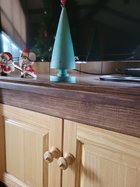I'm an "old" guy when it comes to many forms of woodworking. While not a complete "newbie" to woodturning, I'm certainly not an "old" hand. I have a few tools in my arsenal, rough gouge, scraper, negative rake scraper, bowl gouges, skews, and part tools (made one). I can pick up these tools with a degree of confidence in their proper usage and in understanding my mistakes. But there is another tool that is makes my turning life not so pleasurable. That tool is the 3/8 spindle, detail gouge. I can be making a great cut (for me), then SUDDENLY bam and that is a loud BAM. I have viewed and reviewed several videos on this and other sites regarding this specific tool. Is there a detailed video available on the do's, don'ts, and secrets of this tool? The business end is the traditional fingernail grind.
Happy New Year
Dan
Happy New Year
Dan





